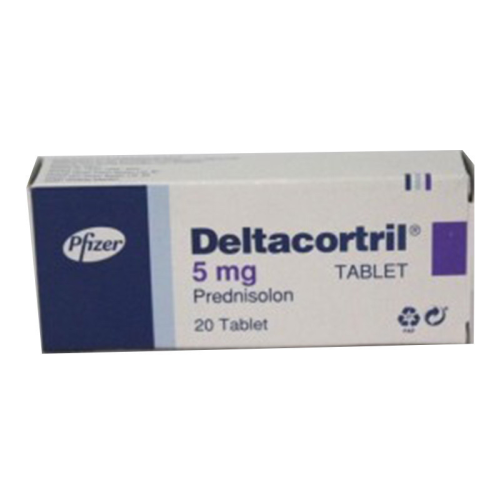CLASSIFICATION
Glucocorticosteroid
DOSAGE
20-30 mg/day
ACNE
No
WATER RETENTION
No
HBR
Possible
HEPATOTOXICITY
No
AROMATIZATION
No
MANUFACTURER
Pfizer
WAREHOUSE
International Warehouse 2
SUBSTANCE
Prednisolone
,
Deltacortril is a glucocorticosteroid that modulates the activity of leukocytes and tissue macrophages. It limits the movement of leukocytes to inflamed areas and interferes with the macrophages' ability to perform phagocytosis and produce interleukin-1. Additionally, Deltacortril stabilizes lysosomal membranes, thereby lowering the concentration of proteolytic enzymes present during inflammation. It also reduces capillary permeability induced by histamine release and inhibits fibroblast activity and collagen synthesis.
Deltacortril works by inhibiting phospholipase A2, which decreases the production of prostaglandins and leukotrienes. It also suppresses the release of COX enzymes (especially COX-2), further diminishing prostaglandin synthesis.
This medication decreases the levels of circulating lymphocytes (both T and B cells), monocytes, eosinophils, and basophils, primarily by directing them from the bloodstream into lymphoid tissues, and it suppresses antibody formation.
Deltacortril reduces the release of ACTH and beta-lipotropin from the pituitary gland, though it does not affect the circulating levels of beta-endorphin. In addition, it inhibits TSH and FSH secretion.
When applied directly to blood vessels, Deltacortril has a vasoconstrictive effect.
In terms of metabolic impact, Deltacortril has significant, dose-dependent effects on carbohydrate, protein, and fat metabolism. It promotes gluconeogenesis and increases amino acid uptake in the liver and kidneys, boosting gluconeogenesis enzyme activity. In the liver, it enhances glycogen storage while promoting glucose synthesis from protein metabolism products. This medicine raises blood glucose levels and stimulates insulin secretion.
Deltacortril also hinders glucose absorption in fat cells, leading to increased lipolysis. However, the surge in insulin secretion ultimately promotes lipogenesis, resulting in fat accumulation.
Additionally, Deltacortril exhibits catabolic effects on lymphoid and connective tissues, muscle, adipose tissue, skin, and bone. Compared to hydrocortisone, its effects on water and electrolyte metabolism are milder, promoting potassium and calcium loss while retaining sodium and fluid. Long-term corticosteroid therapy can lead to conditions such as osteoporosis and Cushing's syndrome, and in children, may hinder growth.
At high doses, prednisone can elevate brain tissue excitability and reduce the convulsive threshold. It may also increase hydrochloric acid and pepsin production in the stomach, heightening the risk of peptic ulcers.
Deltacortril's therapeutic benefits when used systemically stem from its anti-inflammatory, antiallergic, immunosuppressive, and antiproliferative properties. For local and external application, its efficacy is attributed to its anti-inflammatory and vasoconstrictive effects.
In comparison to hydrocortisone, Deltacortril's anti-inflammatory effects are four times more potent, while its mineralocorticoid activity is about 60% less.
Indications for Deltacortril:For oral and parenteral administration: it is prescribed for conditions such as rheumatism, rheumatoid arthritis, dermatomyositis, periarteritis nodosa, scleroderma, ankylosing spondylitis, asthma, acute and chronic allergic reactions, Anaphylaxis, Addison's disease, acute adrenal insufficiency, and adrenal-genital syndrome; liver conditions, hypoglycemia, lipid nephrosis; agranulocytosis, various leukemias, lymphomas, thrombocytopenic purpura, hemolytic anemia; chorea; skin conditions such as pemphigus, eczema, pruritus, to exfoliative dermatitis, psoriasis, seborrheic dermatitis, systemic lupus erythematosus (SLE), erythroderma, and hair loss.
For intra-articular administration: it may be used for chronic arthritis, post-traumatic arthritis, osteoarthritis in larger joints, and rheumatic joint destruction.
For infiltration into tissues: it is indicated for epicondylitis, tenosynovitis, bursitis, frozen shoulder, keloids, sciatica, Dupuytren's contracture, and other joint and soft tissue disorders.
In ophthalmology: it is prescribed for allergies, chronic and atypical conjunctivitis, blepharitis, corneal inflammation with intact mucosa, acute and chronic anterior choroid inflammation, sclera and episcleritis, sympathetic eye inflammation, and post-injury or post-surgery care.
Dosage and Administration:For oral administration in adults on replacement therapy, the starting dose is 20-30 mg, with a maintenance dose of 10-15 mg daily. If necessary, initial doses may range from 15-100 mg per day, with maintenance doses between 5-15 mg daily. Doses should be tapered down gradually. For children, a starting dose of 1-2 mg/kg divided into 4-6 doses is recommended, with a maintenance dose of 3-6 mg/kg per day.
For intramuscular or intravenous administration, the frequency and duration are tailored to the individual.
For intra-articular administration: 25-50 mg is used for larger joints, 10-25 mg for medium-sized joints, and 5-10 mg for smaller joints. For tissue infiltration, doses ranging from 5 mg to 50 mg are used depending on the severity of the condition.
In ophthalmology, Deltacortril is applied three times daily for no longer than 14 days; in dermatology, it is used once to three times daily.
Side Effects and Adverse Reactions:Endocrine system: menstrual irregularities, adrenal function suppression, Cushing's syndrome, pituitary-adrenal system suppression, decreased carbohydrate tolerance, steroid diabetes, growth retardation in children, and delayed sexual development.
Digestive system: nausea, vomiting, steroid-induced peptic and duodenal ulcers, pancreatitis, esophagitis, gastrointestinal bleeding, changes in appetite, flatulence, and hiccups. There may also be rare increases in liver transaminases and alkaline phosphatase.
Metabolic effects: negative nitrogen balance due to protein catabolism, increased calcium excretion leading to hypocalcemia, weight gain, and hyperhidrosis (excessive sweating).
Cardiovascular system: potassium loss, hypokalemic alkalosis, arrhythmias, bradycardia, steroid myopathy, worsening of heart failure symptoms, ECG changes consistent with hypokalemia, elevated blood pressure, heightened blood clotting risk, and thrombosis. Following an acute myocardial infarction, it may slow necrosis spread and scar tissue formation, risking heart muscle rupture.
Musculoskeletal system: inhibited growth and ossification in children (risk of early epiphyseal closure) and osteoporosis, with extremely rare cases of pathological fractures or necrosis of the shoulder head and femur, tendon ruptures, muscle weakness, steroid myopathy, and muscle wasting.
Central nervous system: headaches, increased intracranial pressure, confusion, disorientation, fluctuations in mood (euphoria to depression), anxiety, insomnia, dizziness, vertigo, pseudo-tumors of the brain, and seizures.
Vision: risk of posterior subcapsular cataracts, increased intraocular pressure possibly affecting the optic nerve, corneal trophic changes, exophthalmos, and susceptibility to secondary infections such as bacterial, fungal, and viral.
Dermatological effects: small red spots (petechiae), bruising (ecchymosis), thinning and fragility of the skin, changes in pigmentation, acne, stretch marks, and increased risk of skin infections like pyoderma and candidiasis.
Immunosuppressive reactions: includes slower healing rates and reduced infection resistance. For parenteral administration, rare cases may involve anaphylactic and allergic reactions, skin pigmentation changes, tissue atrophy, exacerbation of existing conditions, sterile abscess formation, and intrasinovial injection complications potentially leading to blindness.

